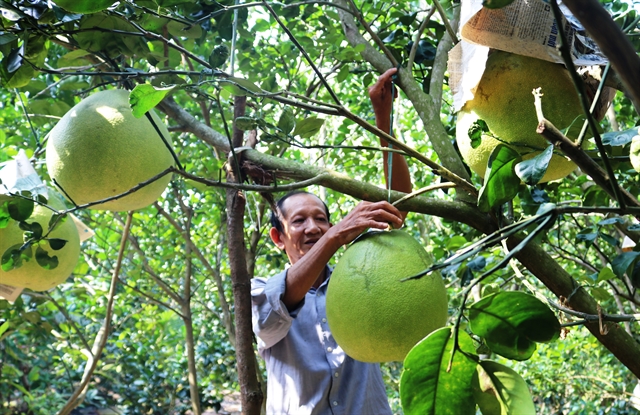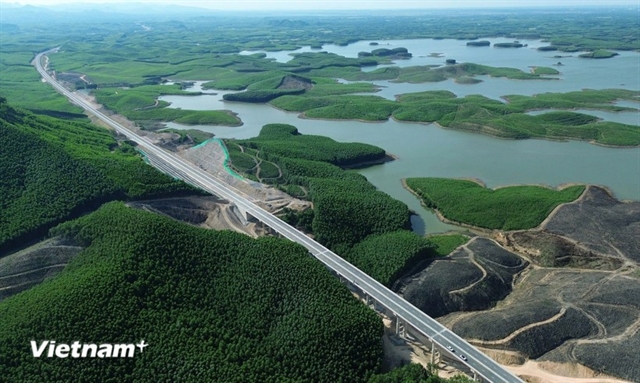 Society
Society

The expansion of fruit growing areas in Tiền Giang Province, the country’s largest fruit producer, has helped farmers adapt to climate change and improve their incomes.

|
| A Thúng grapefruit orchard in Mỹ Tho City in the Mekong Delta Province of Tiền Giang. — VNS Photo Ngọc Diệp |
TIỀN GIANG — The expansion of fruit growing areas in Tiền Giang Province, the country’s largest fruit producer, has helped farmers adapt to climate change and improve their incomes.
The Cửu Long (Mekong) Delta province has more than 77,000ha of fruit, exceeding 4.7 per cent of the province’s target for 2020 for fruit growing areas, its Department of Agriculture and Rural Development has said.
In recent years, local authorities have instructed farmers in Vietnamese and global good agricultural practices (VietGAP and Global GAP) standards and effective fruit growing models.
Võ Văn Nhì in Mỹ Tho City’s Đạo Thạnh Commune, for example, shifted from an ineffective 3,000sq.m rice field to green-skin and pink-flesh grapefruit planted under VietGAP standards, which results in higher quality and better prices. The origin can also be traced and the fruit is considered safe and clean.
He earns an annual profit of VNĐ200 million (US$8,600) from grapefruit cultivation.
Lê Văn Nghĩa, vice chairman of the province’s People’s Committee, said the province depends heavily on its garden economy. Many specialty fruit varieties like durian, dragon fruit and green-skin and pink-flesh grape fruit are exported and have high value.
The province has set up concentrated fruit growing areas for specialty fruits like durian in Cai Lậy District, pineapple in Tân Phước District and Hòa Lộc mango in Cái Bè District.
The province’s Cai Lậy durian has been granted geographical indication certification by the National Office of Intellectual Property.
Tiền Giang has about 100ha of Hòa Lộc mango areas planted under VietGAP standards which are guaranteed outlets by the Hòa Lộc Co-operative in Cái Bè District. The co-operative supplies 100-150 tonnes of Hòa Lộc mango a year to Hà Nội and HCM City markets as well as exporting companies.
High-value fruits
The province has encouraged farmers to switch to high-value fruits in areas where rice farming is ineffective and affected by climate change. The areas are in the Đồng Tháp Mười (Plain of Reeds) region, Gò Công coastal area, flood-prone areas in the Tiền River upper areas, and islets.
In Tân Phú Đông, an islet district affected by saltwater intrusion, farmers have shifted nearly 500ha of rice fields to vegetables and specialty fruit, mostly soursop, this year.
Soursop is a well-known specialty fruit of the district as it is resistant to drought and saltwater intrusion, and has high yield and economic effectiveness.
Local authorities in Ngũ Hiệp and Tân Phong, two islet communes in Cai Lậy District, have decided that fruit would be the key crop in the communes which have favourable conditions for fruit cultivation. Ngũ Hiệp has 1,513ha of durian, accounting for 98 per cent of the commune’s farming area.
Huỳnh Văn Phải, who grows durian in Ngũ Hiệp’s Tân Sơn Commune, said: “With its soil advantage, Ngũ Hiệp islet has conditions for developing durian growing area.”
Many durian farmers have earned very high incomes switching to high-quality durian like Monthong and Ri6, he said.
In Tân Phong, 98 per cent of the commune’s 1,352ha farming areas have been developed into orchards for growing durian, Thai jackfruit, rambutan and Ido longan.
Nguyễn Kim Đổng, who grows 6,000sq.m of Ido longan in Tân Phong Commune’s Tân Bường A Hamlet, said that Ido longan had become a promising fruit in Tân Phong Islet as it has high yield and is resistant to diseases.
The commune’s new road and irrigation systems have also helped farmers, he said.
“With the orientation of producing safe and clean agricultural products, we hope to have stable outlets for our fruit and to improve the effectiveness of orchards,” he said. – VNS




